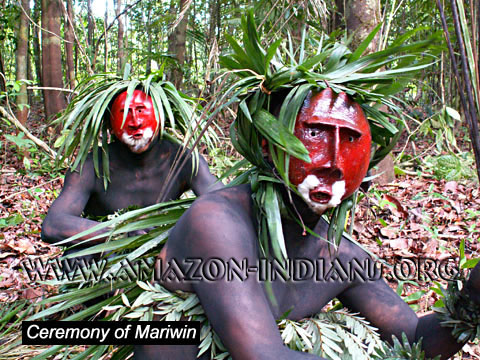 |
Believe it or not, not that far from Iquitos, Peru you can encounter recently discovered tribes of the Amazon. In the Javari (Yavarí) Valley (the frontier of Peru with Brazil) the Matis Indians (not to be confused with the Matsés) still live like they have for thousands of years – hunting and gathering. At one time, before inventing agriculture and pastoralism, the entire human race survived as hunter-gatherers. Today, only a hand-full of Amazonian tribes practice this ancient way of life. An encounter with a tribe like the Matis is more than a curiosity; it is a glimpse into the past – into our past and gives us a chance to see how our ancestors were.
And how are the Matis Indians? After spending many years researching them and related tribes, I can tell you that they are very nice people and have a society that in many ways is healthier than so called "civilized societies." I remember a friend of mine from Iquitos telling me that the less time a tribe has had contact with civilization, the nicer the people are. After knowing the Matis tribe, I realize that he was right.
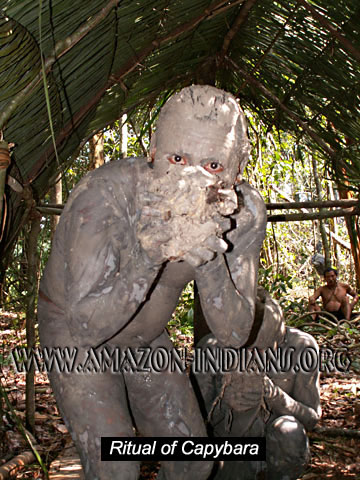 I am a scientist by trade (having studied and taught anthropology as a graduate student and being awarded a Ph.D. in Ecology from the University of California, Davis) and originally never planned to live permanently in the Amazon. However after meeting the Matis tribe, I could not bring myself to leave and chose to remain in the Amazon where I have been living for the last seven years. The Matis Indians are so interesting and so wonderful that I decided to take this opportunity of a lifetime to study them. I realize that a few generations from now that they may change and be absorbed by western society, no longer practicing their ancient way of life. Here was my chance to know the Matis tribe, the last of the hunters, and through them learn how our ancestors were.
I am a scientist by trade (having studied and taught anthropology as a graduate student and being awarded a Ph.D. in Ecology from the University of California, Davis) and originally never planned to live permanently in the Amazon. However after meeting the Matis tribe, I could not bring myself to leave and chose to remain in the Amazon where I have been living for the last seven years. The Matis Indians are so interesting and so wonderful that I decided to take this opportunity of a lifetime to study them. I realize that a few generations from now that they may change and be absorbed by western society, no longer practicing their ancient way of life. Here was my chance to know the Matis tribe, the last of the hunters, and through them learn how our ancestors were.Although the Matis Indians do cultivate some horticultural crops to supplement their diet, the Matis are primarily hunters and specialists in blowgun hunting. I remember a tourist guide erroneously telling me that no tribe in the Amazon uses four-meter blowguns for hunting. He was wrong; the Matis natives use four-meter blowguns and curare-tipped poison darts to capture their prey. Similarly, many tourist guides mistakenly told me that it was no longer possible to encounter unclothed indians. Again, they were misinformed, as many older Matis Indians are still very traditional and commonly wear no clothes. To truly appreciate how the Matis Indians live, you need to view my documentary films which are available on DVD.
The Matis Indians are perhaps the most exotic and photogenic tribe in the world. They use facial ornamentation and tattoos to imitate the appearance of a jaguar. They have a very rich culture and many beautiful ceremonies such as the Ceremony of Mariwin, the Ritual of Capybara, the Dance of Queixada, and the Poison Frog Ceremony. The Ceremony of Mariwin is very colorful as the participants paint their bodies black, wearing only green leaves and red masks. The masked beings represent "ancestral spirits" and carry whips that they most commonly use to strike children and women, an act that is thought by the Matis to transfer "energy" to the recipient from the spirits. While less colorful than Mariwin, the Ritual of Capybara is more 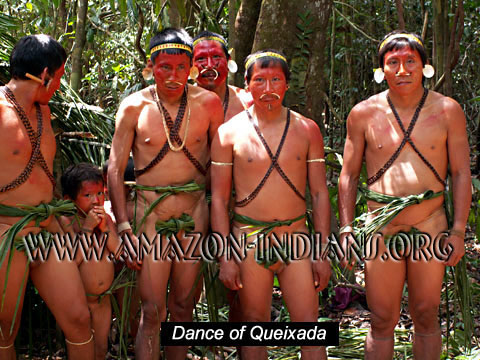 musical. During this ceremony, the participants are also unclothed, but do not paint their bodies. Instead they apply wet clay to their bodies and make sounds like the capybaras (Hydrochoeris hydrochaeris), the world’s largest rodent, creating an atmosphere that is not only visually stimulating but auditory as well. During the Dance of Queixada, the participants paint themselves red with urucum (annatto) and dance in a line while imitating sounds of the queixada (Tayassu pecari, a wild boar that is native to the Amazon). The Poison Frog Ceremony involves the use of a toxin secreted by the skin of a poisonous frog (Phyllomedusa bicolor). First several points are burned on the skin (arms of men and abdomens of women). The outer layer of the skin is removed and the frog toxin mixed with human saliva (to activate it) is applied to the wound. Although not hallucinogenic, the physiological response is very intense and the Matis natives believe the frog poison increases ones strength and endurance, making them better hunters. The frog poison ceremony is similar to the Mariwin ceremony in that there is a transfer of energy from the donor (in this case, typically an older and wiser male) to the receiver (often a younger and less experienced male).
musical. During this ceremony, the participants are also unclothed, but do not paint their bodies. Instead they apply wet clay to their bodies and make sounds like the capybaras (Hydrochoeris hydrochaeris), the world’s largest rodent, creating an atmosphere that is not only visually stimulating but auditory as well. During the Dance of Queixada, the participants paint themselves red with urucum (annatto) and dance in a line while imitating sounds of the queixada (Tayassu pecari, a wild boar that is native to the Amazon). The Poison Frog Ceremony involves the use of a toxin secreted by the skin of a poisonous frog (Phyllomedusa bicolor). First several points are burned on the skin (arms of men and abdomens of women). The outer layer of the skin is removed and the frog toxin mixed with human saliva (to activate it) is applied to the wound. Although not hallucinogenic, the physiological response is very intense and the Matis natives believe the frog poison increases ones strength and endurance, making them better hunters. The frog poison ceremony is similar to the Mariwin ceremony in that there is a transfer of energy from the donor (in this case, typically an older and wiser male) to the receiver (often a younger and less experienced male).
 musical. During this ceremony, the participants are also unclothed, but do not paint their bodies. Instead they apply wet clay to their bodies and make sounds like the capybaras (Hydrochoeris hydrochaeris), the world’s largest rodent, creating an atmosphere that is not only visually stimulating but auditory as well. During the Dance of Queixada, the participants paint themselves red with urucum (annatto) and dance in a line while imitating sounds of the queixada (Tayassu pecari, a wild boar that is native to the Amazon). The Poison Frog Ceremony involves the use of a toxin secreted by the skin of a poisonous frog (Phyllomedusa bicolor). First several points are burned on the skin (arms of men and abdomens of women). The outer layer of the skin is removed and the frog toxin mixed with human saliva (to activate it) is applied to the wound. Although not hallucinogenic, the physiological response is very intense and the Matis natives believe the frog poison increases ones strength and endurance, making them better hunters. The frog poison ceremony is similar to the Mariwin ceremony in that there is a transfer of energy from the donor (in this case, typically an older and wiser male) to the receiver (often a younger and less experienced male).
musical. During this ceremony, the participants are also unclothed, but do not paint their bodies. Instead they apply wet clay to their bodies and make sounds like the capybaras (Hydrochoeris hydrochaeris), the world’s largest rodent, creating an atmosphere that is not only visually stimulating but auditory as well. During the Dance of Queixada, the participants paint themselves red with urucum (annatto) and dance in a line while imitating sounds of the queixada (Tayassu pecari, a wild boar that is native to the Amazon). The Poison Frog Ceremony involves the use of a toxin secreted by the skin of a poisonous frog (Phyllomedusa bicolor). First several points are burned on the skin (arms of men and abdomens of women). The outer layer of the skin is removed and the frog toxin mixed with human saliva (to activate it) is applied to the wound. Although not hallucinogenic, the physiological response is very intense and the Matis natives believe the frog poison increases ones strength and endurance, making them better hunters. The frog poison ceremony is similar to the Mariwin ceremony in that there is a transfer of energy from the donor (in this case, typically an older and wiser male) to the receiver (often a younger and less experienced male). 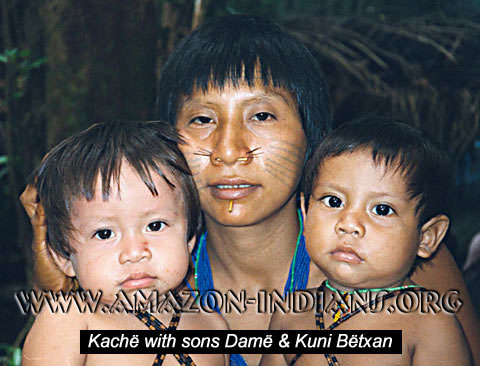 Not only do the Matis Indians hunt, but they fish as well. However traditionally they do not use hooks or nets. Instead they rely on their knowledge of the plants of the jungle. They use a plant called huaca which they process by adding the plant to clay and fermenting it. When added to a body of water such as a lake,huaca depletes the oxygen and the fish float to the surface where the Matis harvest them.
Not only do the Matis Indians hunt, but they fish as well. However traditionally they do not use hooks or nets. Instead they rely on their knowledge of the plants of the jungle. They use a plant called huaca which they process by adding the plant to clay and fermenting it. When added to a body of water such as a lake,huaca depletes the oxygen and the fish float to the surface where the Matis harvest them.The Matis natives know many other secrets of the plants of the jungle, including medicinal uses. If they lose their traditions and only use western medicine, many of these secrets will be lost and this is precisely why I as a scientist wish to preserve this important knowledge of plants and preserve the Matis culture.
Currently, the greatest danger to the Matis tribe is hepatitis. Consequently I have been working on a project that has been installing clean water systems (water wells) in indigenous communities in the Javari (Yavarí) Valley that will help eliminate the threat of hepatitis and parasites which are currently common sources of illnesses. To combat malaria, I have been donating microscopes and solar-power energy systems to various isolated native communities in the Javari River area in order that they themselves can diagnose and treat malaria. Without their own microscopes, natives are required to make a long and expensive journey to regional health posts, often dying before being diagnosed or receiving treatment. Having their own diagnostic capabilities allow these indigenous Amazonians to be empowered with their own medical care, and not be dependent on and controlled by outsiders.
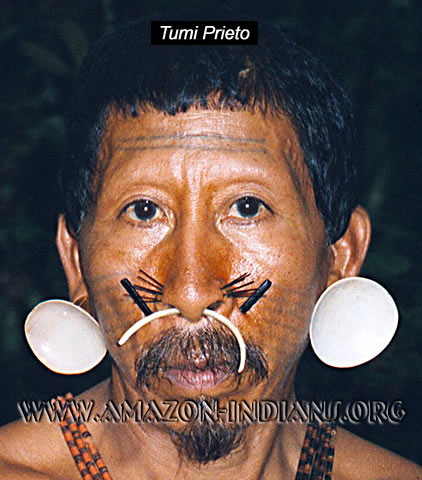 The Matis Indians are a very small tribe of only about 300 individuals and the two villages where the Matis live (Aurelio and Beija Flor) are located in an indigenous reserve in Brazil. Despite the misrepresentations by some tourist guides, it is prohibited for outsiders to enter the reserve and impossible to meet the Matis Indians using tour guides. Commercial tourism and tour guides are prohibited as the tour guides have consistently exploited the Matis Indians in the past. However, it is possible to arrange encounters of interested persons directly with the Matis tribe outside of their reserve. The Matis are a very proud people who wish not only to preserve their culture, but also would like to demonstrate their ceremonies and rituals to select outsiders. If you would like to learn how you can meet the Matis Indians and find out how you can help them preserve their culture, please contact me at djpantone@amazon-indians.org.
The Matis Indians are a very small tribe of only about 300 individuals and the two villages where the Matis live (Aurelio and Beija Flor) are located in an indigenous reserve in Brazil. Despite the misrepresentations by some tourist guides, it is prohibited for outsiders to enter the reserve and impossible to meet the Matis Indians using tour guides. Commercial tourism and tour guides are prohibited as the tour guides have consistently exploited the Matis Indians in the past. However, it is possible to arrange encounters of interested persons directly with the Matis tribe outside of their reserve. The Matis are a very proud people who wish not only to preserve their culture, but also would like to demonstrate their ceremonies and rituals to select outsiders. If you would like to learn how you can meet the Matis Indians and find out how you can help them preserve their culture, please contact me at djpantone@amazon-indians.org.To view more photographs of the Matis Indians, please visit the Matis Photo Gallery. Documentary films of my expeditions with the Matis Indians are available on video.
The author, Dr. Dan James Pantone, is the editor of Amazon-Indians.org, an ecologist, and the founder of the Movement in the Amazon for Tribal Subsistence and Economic Sustainability (MATSES), a non-governmental organization that is helping indigenous people so that they themselves can preserve their culture and lands in a sustainable and independent manner.
No comments:
Post a Comment